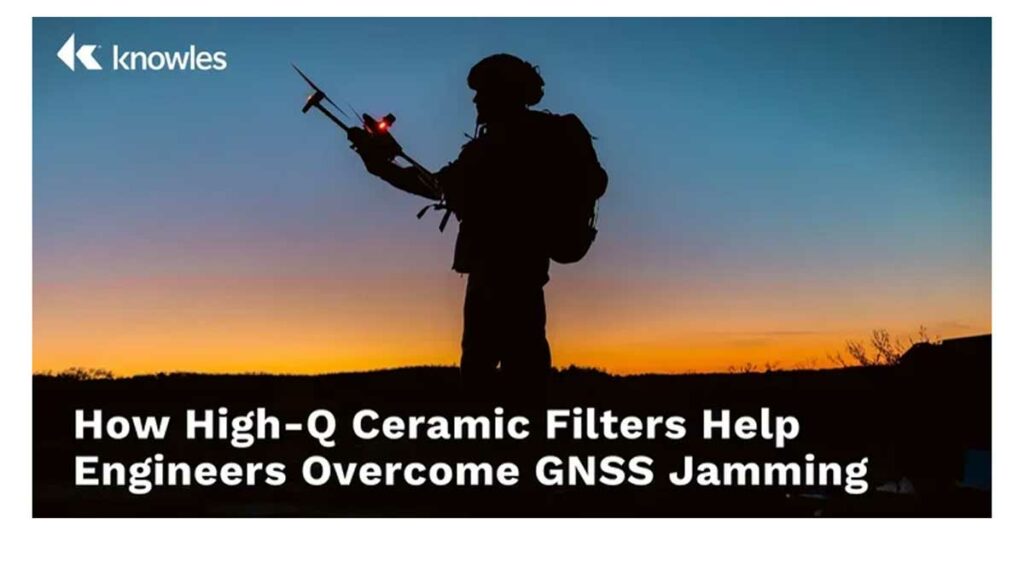This article based on Knowles Precision Devices blog explains how high-Q ceramic filters help engineers to overcome GNSS jamming.
Engineers are integrating receivers for Global Navigation Satellite Systems (GNSS), such as GPS and Galileo, into various systems, including autonomous vehicles and precision agriculture. However, this integration has led to a crowded RF environment, making it challenging to maintain signal integrity.
Such receivers often operate in environments saturated with electronic interference, making them susceptible to jamming—the intentional or unintentional transmission of radio signals that disrupt GNSS reception. Even low-power jamming can degrade positioning accuracy or completely block signal acquisition.
High-Q ceramic bandpass filters present a technical opportunity to develop jamming-resistant GNSS for mission-critical applications.
How Interference Impacts GNSS Signal Integrity
GNSS receivers rely on isolated and amplified satellite signals, starting at approximately -130 dBm. In congested RF environments, adjacent-band signals and deliberate jamming can easily overpower these weak inputs.
Bandpass filters play a crucial role in mitigating GNSS jamming by isolating legitimate satellite signals from interference. These filters are designed to allow frequencies within the GNSS operational bands (e.g., GPS L1/L2, Galileo E1/E5) while attenuating out-of-band noise and intentional jamming signals.
Surface Acoustic Wave (SAW) filters, with their low cost and compact form factor, are a natural choice for GNSS receivers. However, they struggle in high-interference conditions due to limited out-of-band rejection and broader skirts.
While SAW filters continue to meet performance requirements for consumer devices and systems, high-Q ceramic filters offer a robust upgrade for mission-critical applications that demand mechanical and thermal stability, predictable tuning characteristics, and long-term reliability.
The significance of Q Factor in GNSS Filtering
Q factor, a shorthand figure of merit (FOM) for RF filters, is expressed as the ratio of stored versus lost energy per oscillation cycle. It quantifies specifications such as the steepness of skirts (selectivity) and insertion loss. As Q factor decreases, losses through a resonator increase, and this increase accelerates with frequency for lower values of resonator Q.
Knowles’ high-Q ceramic filters excel over many alternatives by offering:
- Sharper skirts: Enabling precise filtering near band edges.
- High rejection: Attenuating out-of-band signals and jammers.
- Low insertion loss: Preserving the integrity of weak GNSS signals.
These attributes are particularly crucial in military and aerospace platforms where GNSS must function reliably despite hostile electronic countermeasures. High-Q ceramic filters enable precise frequency discrimination, ensuring only legitimate GNSS signals reach the receiver.
Consider scenarios like a drone conducting reconnaissance in a contested area or an autonomous harvester navigating with sub-inch precision on a farm. Both require high signal clarity. Knowles’ high-Q ceramic filters, such as the GPS L1, are engineered for use in L-band GNSS applications. These filters demonstrate low passband insertion loss (<2.0 dB), high out-of-band rejection (up to 40 dB), and compact dimensions, making them ideal for both portable and embedded systems.
As GNSS technologies become increasingly integrated into critical infrastructure, the demand for high-performance filtering solutions grows. High-Q ceramic filters from Knowles play a vital role in establishing precise signal control and jamming resistance.
For detailed specifications, refer to the GPS L1 filter datasheet.
